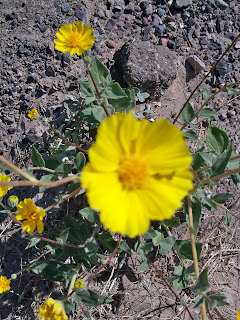
DEATH VALLEY
Great extremes haunt this hottest, driest, lowest national park. Extremes in temperature and elevation create scenic vistas. This desert supports nearly 1,000 native plant species and harbors fish, snails, and other aquatic animals found nowhere else. To protect its extraordinary natural and cultural landscape, in 1944 Congress changed Death Valley from a national monument to a national park, enlarged the park and designated most of it as wilderness.
Great extremes haunt this hottest, driest, lowest national park. Extremes in temperature and elevation create scenic vistas. This desert supports nearly 1,000 native plant species and harbors fish, snails, and other aquatic animals found nowhere else. To protect its extraordinary natural and cultural landscape, in 1944 Congress changed Death Valley from a national monument to a national park, enlarged the park and designated most of it as wilderness.

Our first stop was at Zabriskie Point overlook for an unforgettable view of Death Valley's wildly eroded and vibrantly colored badlands.

Death Valley is the hottest and driest place in the United States. Here is Bill standing at sea level with (guess who) Stanley! The valley is a long, narrow basin 282 feet below sea level, yet walled by high, steep mountain ranges. Summer highs are in the 120 degree range, making that time of year a poor one to visit. On May 5, it was 105 degrees!

Rusting remains of buildings, machinery, tanks, and piping at Harmony Borax Works remain of the operation that dates back more than 120 years. After borax was found in 1881, William Tell Coleman built the Harmony plant and began to process ore in late 1883 or early 1884.

When in full operation, the works employed 40 men who produced three tons of borax daily from the salt flats located behind Bill.

TWENTY MULE TEAM BORAX
Remember that?? Early miners used those famed 20-mule teams to haul borax 165 miles through the Mojave Desert to the railroad town of Mojave, CA. The teams averaged 2 miles an hour and required about 30 days to complete a round trip. The two wagons hauled 24 tons of borax. Combined with the water wagon, the load total was about 36 1/2 tons!

Even in this arid, desolate, hot environment, a brilliant yellow flower blooms.

On the way out of the Park, we took the "Twenty Mule Team Canyon Road". 'Road' is a stretch of the imagination! This narrow, winding one lane road wanders through a desolate area, which was surprisingly beautiful.
While visiting Death Valley we stayed at the Longstreet RV Park. They advertised the largest Holstein bull in the world. He stands over 6 feet tall at the shoulder. The fence was about 5 feet tall.
I don't know what their infatuation was with Holstein cows in the desert, but they also had this huge statue, must have been 12-15 feet high!
How many times did you see Stanley??
I don't know what their infatuation was with Holstein cows in the desert, but they also had this huge statue, must have been 12-15 feet high!
How many times did you see Stanley??



No comments:
Post a Comment